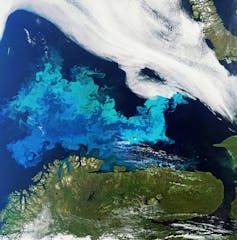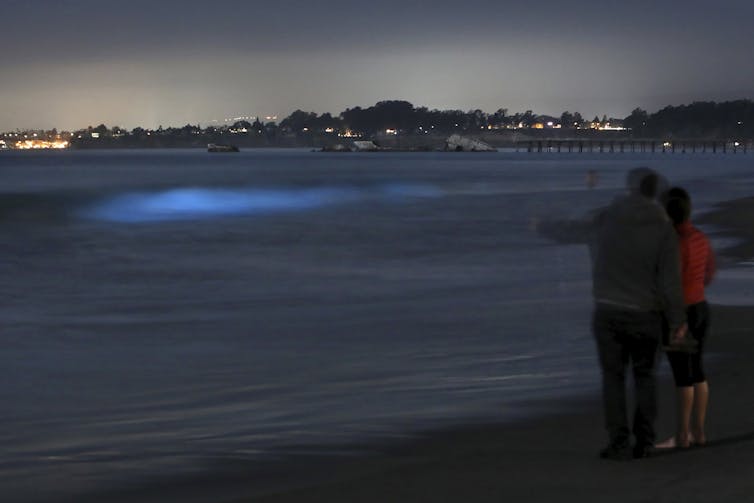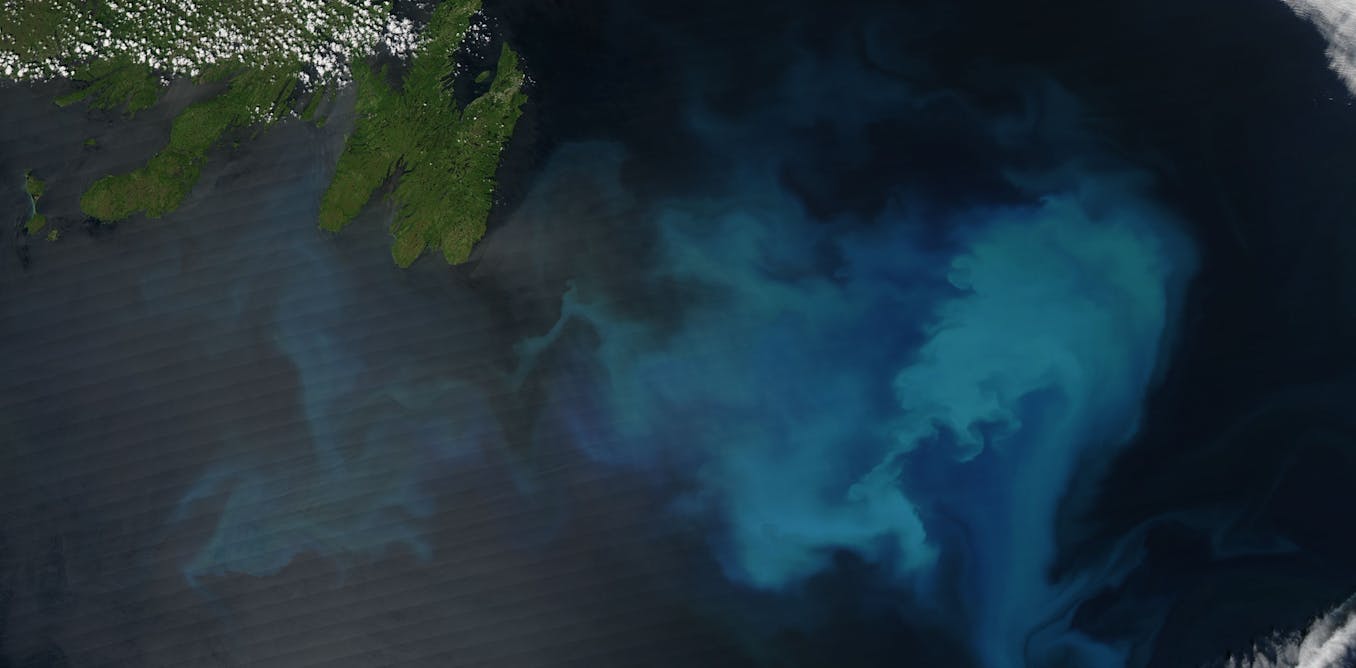Every year in the mid-latitudes of the planet, a peculiar phenomenon known as the phytoplankton spring bloom occurs. Visible from space, spectacular large and ephemeral filament-like shades of green and blue are shaped by the ocean currents.
The phytoplankton blooms are comprised of a myriad of microscopic algae cells growing and accumulating at the ocean’s surface as a result of the onset of longer days and fewer storms — often associated with the move into spring.
Read more:
How climate change-induced stress is altering fish hormones — with huge repercussions for reproduction
The timing of the phytoplankton spring bloom is, however, likely to be altered in response to climate change. Changes which will affect — for good or ill — the many species that are ecologically adapted to benefit from the enhanced feeding opportunity that blooms represent at crucial stages of their development.
Fine-tuned ecological adaptation
Phytoplankton blooms are, in some aspects, metronomes of the annual oceanic cycles around which many species’ biological clocks are synced to.
One example is the zooplankton Calanus finmarchicus, a class of micro-organism only capable of swimming up and down through the water column. Calanus finmarchicus usually spend the winter in diapause — the marine version of hibernation — surviving on their accumulated energy reserves in the deep ocean. At the moment they deem appropriate in the spring, they raise from the abyss to graze on the bloom and reproduce.
(Shutterstock)
Fish and shellfish, too, are adapted to this natural metronome.
For some species, such as shrimp, females strategically lay their eggs in the water in advance of these blooms so their young will have ample food supplies from the moment they hatch
As incredible as it seems, some species can “calculate” the egg incubation period so that eggs hatch on average within a week of the expected spring bloom.
A question of timing
This, unfortunately, is where climate change is entering into the equation. What was normal in the past may well be changing more rapidly than marine species can adapt.
Zooplankton and fish larvae constitutes the bulk of what ocean scientists call secondary production. Secondary production is a key trophic level that links primary production (the phytoplankton using the sun’s light to produce biomass) and higher trophic levels, such as fish and marine mammals.

(ESA, Envisat Pillars)
This grand relationship is known as a trophic cascade, as the zooplankton are eaten by the small fish and the small fish, in turn, are eaten by the bigger fish. A whole ecosystem beating on a clock largely determined by the timing of the phytoplankton spring bloom, hopefully in sync with the biological clocks of other species.
Any change to the timing of the spring bloom, for example as a result of climate change, can potentially have catastrophic consequences for the survival of zooplankton populations alongside the fishes and ecosystems which rely upon this abundant foodstuff.
This theory is known as the match/mismatch hypothesis and postulates that the consumer’s energy demand should “match” the peak resource availability
A new understanding
On the Newfoundland and Labrador shelf in the Northwest Atlantic, the spring bloom generally starts earlier in the south (mid-March on the Grand Banks of Newfoundland) and later in the north (late April on the southern Labrador shelf).
The south-to-north progression of the bloom was long believed to be related to the annual retreat of sea ice in the region.
But with the duration and spatial extent of the sea ice season being dramatically reduced in Atlantic Canada over the recent years, the relationship between sea ice and the timing of the bloom weakened.
I — alongside a team of researchers from across Canada — proposed a new theory to explain the initiation of the spring bloom on the Newfoundland and Labrador shelf.

(Shmuel Thaler/The Santa Cruz Sentinel via AP)
Our theory points to transition from winter to spring as being key to trigger the bloom. In winter, cold and stormy conditions keep the ocean well mixed. However, the arrival of spring brings calmer winds and warming temperatures — coupled with increased freshwater flows. These conditions cause the ocean to reorganize into layers of different density — a phenomenon called re-stratification.
Re-stratification effectively prevents the phytoplankton cells of the upper layers from becoming easily mixed in the maelstrom of oceanic forces.
Their accumulation at the ocean’s surface creates the bloom.
This new mechanism successfully predicts the timing of the phytoplankton spring bloom over more than two decades. It also allows us to better understand the impacts that climate change is having upon our oceans.
Ecological significance
Located at the confluence of sub-arctic and sub-tropical ocean currents, the Newfoundland and Labrador shelf is naturally subjected to large fluctuations of its climate, with impacts on the timing of the bloom.
Our study has shown that a warmer climate is associated with earlier re-stratification, earlier phytoplankton blooms and a higher abundance of key zooplankton species such as Calanus finmarchicus in the region.
Read more:
Climate change is further reducing fish stocks with worrisome implications for global food supplies
This discovery opens the door to a better understanding of bloom dynamics and the oceanic conditions driving the health of the ecosystem.
The good news for a cold region such as the Newfoundland and Labrador shelf is that a warmer climate with milder springs, like the ones we have seen in recent years, will lead to more and more abundant levels of phytoplankton — with clear benefits to ecosystem productivity.
However, for how long these changes will remain positive in a changing climate we cannot say.




